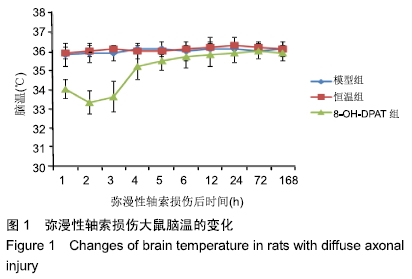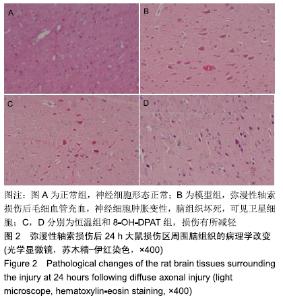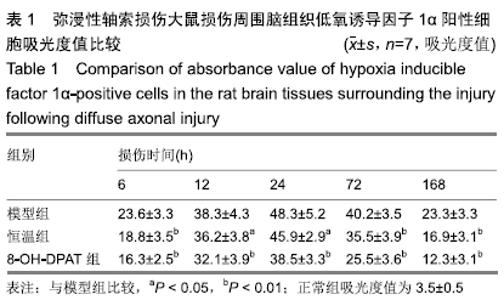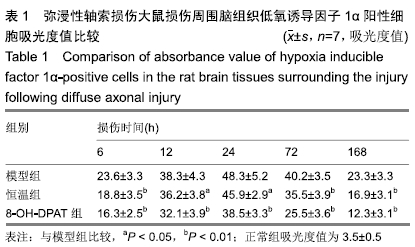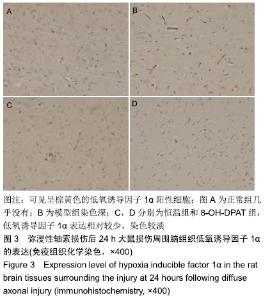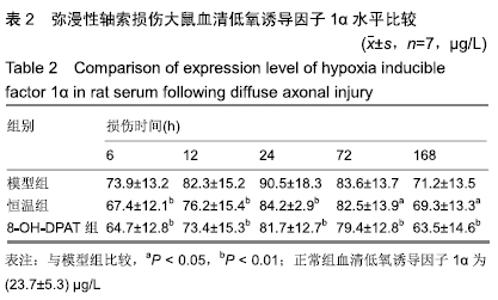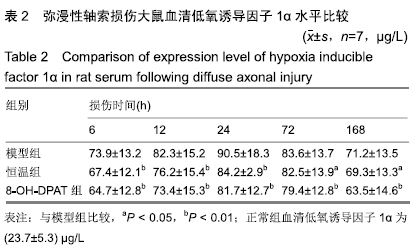[1] REYNOLDS CA, KALLAKURI S, BAGCHI M, et al.Endothelin receptor A antagonism reduces the extent of diffuse axonal injury in a rodent model of traumatic brain injury.Neurol Res.2011;33(2):192-196.
[2] 李宽正,徐建军,徐书源,等.尼莫地平联合甘露醇对大鼠弥漫性轴索损伤治疗效果[J].中国实用神经疾病杂志,2012,15(20):3-5.
[3] 林晖,蔡智基,丁志君.颅内压及灌注压监测在弥漫性轴索损伤中的应用[J].创伤外科杂志,2017,19(12):900-903.
[4] GUO JD, O'FLAHERTY BM, RAINNIE DG.Serotonin gating of cortical and thalamic glutamate inputs onto principal neurons of the basolateral amygdala.Neuropharmacology.2017;126:224-232.
[5] 李宾,宋振全,梁国标,等.8-OH-DPAT对弥漫性脑损伤及合并二次脑损伤大鼠神经元凋亡的影响[J].创伤外科杂志,2013,15(4):310-314.
[6] MAO ZL,SONG ZQ,LI G,et al. 8-hydroxy-2-(di-n-propylamino) tetralin intervenes with neural cell apoptosis following diffuse axonal injury. Neural Regen Res.2013;8(2):133-142.
[7] GUI L, LIU B, LV G.Hypoxia induces autophagy in cardiomyocytes via a hypoxia-inducible factor 1-dependent mechanism. Exp Ther Med. 2016;11(6):2233-2239.
[8] 中华人民共和国科学技术部.关于善待实验动物的指导性意见. 2006-09-30.
[9] MARMAROU A, FODA MA, VAN DEN BRINK W, et al.A new model of diffuse brain injury in rats. Part I: Pathophysiology and biomechanics.J Neurosurg. 1994;80(2):291-300.
[10] 张鹏.基于iTRAQ技术的SD大鼠弥漫性轴索损伤的蛋白质组学研究[D].重庆:重庆医科大学,2018.
[11] GLUSHAKOVA OY,GLUSHAKOV AO,BORLONGAN CV,et al.Role of Caspase-3- Mediated Apoptosis in Chronic Caspase-3-Cleaved Tau Accumulation and Blood-Brain Barrier Damage in the Corpus Callosum after Traumatic Brain Injury in Rats.J Neurotrauma. 2018; 35(1):157-173.
[12] BERNER NJ,GRAHN DA,Heller HC.8-OH-DPAT-sensitive neurons in the nucleus raphe magnus modulate thermoregulatory output in rats. Brain Res.1999;831(1-2):155-164.
[13] 杨莹,李邦东,赵瑞波.亚低温对缺血再灌注鼠脑LN与MMP-9表达的影响及意义[J].哈尔滨医科大学学报,2007,41(3):214-217.张赛,只达石. 亚低温脑保护的研究进展[J].中国综合临床,2003,19(4):289-291.
[14] 汪俊.亚低温疗法对脑出血患者血清炎性因子水平及预后的影响[J]. 神经损伤与功能重建, 2018,13(6):50-51.
[15] 阮晓兰,刘春英,苗瑞杰.局部亚低温治疗急性大面积脑梗死患者的疗效和血清中神经元特异性烯醇化酶浓度、超氧化物歧化酶活力及一氧化氮浓度变化分析[J].脑与神经疾病杂志,2018,26(1):26-29.
[16] 宋斐斐,郭岑,鲍海峰,等.亚低温对脑出血后炎症反应的作用及机制研究[J].中国临床神经科学,2018(2):197-205.
[17] 邬刚,吴海燕,战丽萍,等.颅脑损伤患者血清脑红蛋白与低氧诱导因子1α水平的变化及临床意义[J].中国现代医学杂志,2018,28(21):108-113.
[18] 任冬青,马永丰,华玉芳,等.丙泊酚对大鼠局灶性脑缺血-再灌注低氧诱导因子-1和热休克蛋白70的影响[J].临床麻醉学杂志,2008,24(3): 242-243.
[19] 刘颂华,胡结明,方锦霞,等.醒脑静注射液对缺氧缺血性脑损伤大鼠S100B蛋白及低氧诱导因子-1α和血管内皮生长因子表达的影响[J].中华实用诊断与治疗杂志,2015,29(12):1176-1178.
[20] 王晓萍,赵燊,林庆明,等.亚低温对大鼠脑出血后脑水肿及缺氧诱导因子-1α、血管内皮生长因子表达的影响[J].中华急诊医学杂志,2013,22(5): 496-500.
[21] YAKOVLEV AG, KNOBLACH SM, FAN L, et al.Activation of CPP32-like Caspases contributes to neuronal apoptosis and neurological dysfunction after traumatic brain injury.J Neurosci.1997; 17(19):7415-7424.
[22] 王依凝,安帅.低氧诱导因子1α对周围神经系统损伤修复的影响[J].医学综述,2018,24(3):434-437.
[23] CAPUANO B, CROSBY IT, MCROBB FM, et al. JL13 has clozapine- like actions on thermoregulatory cutaneous blood flow in rats: Involvement of serotonin 5-HT1A and 5-HT2A receptor mechanisms. Prog Neuropsychopharmacol Biol Psychiatry.2010;34(1):136-142.
[24] JIANG DG, JIN SL, LI GY, et al.Serotonin regulates brain-derived neurotrophic factor expression in select brain regions during acute psychological stress.Neural Regen Res.2016;11(9):1471-1479.
[25] KLINE AE, YU J, MASSUCCI JL, et al.Protective effects of the 5-HT1A receptor agonist 8-hydroxy-2-(di-n- propylamino) tetralin against traumatic brain injury-induced cognitive deficits and neuropathology in adult male rats. Neurosci Lett.2002;333(3):179-182.
[26] 李立博,李坤颖,郭方圆,等.激活或阻断内侧隔斜角带复合体中5-HT1A受体对帕金森病模型大鼠认知功能的影响[J].2018;39(4):488-492,497.
[27] 宋振全,李刚,赵明光,等.5-HT1A受体激动剂(8-OH-DPAT)对大鼠弥漫性轴索损伤神经保护作用的实验研究[J].临床军医杂志,2012,40(4): 757-761.
[28] 杨萍. 5-HT1A受体激动剂8-OH-DPAT对癫痫合并抑郁神经可塑性影响的研究[D].太原:山西医科大学,2011.
[29] 蔡亚兰,陈竹,赵媛,等.5-HT1A受体激动剂对青春期大鼠病理性攻击行为和前额叶皮质、海马内脑源性及胶质细胞源性神经营养因子的影响[J].第二军医大学学报,2017,38(7):885-890.
[30] 司天梅,陈胜良,郝伟,等.5-HT_(1A)受体参与常见精神疾病病理机制及5-HT_(1A)受体部分激动剂的潜在治疗效应研究进展[J].中国新药与临床杂志,2018,37(9):8-13.
|

